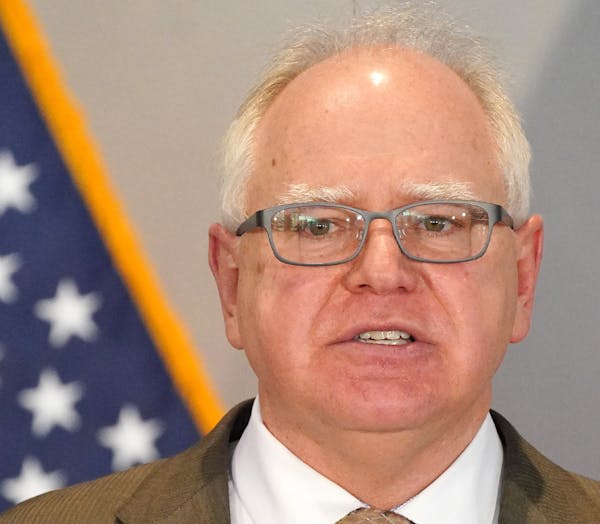More than 1 million households would see a tax cut — albeit a small one — under the piece of Gov. Tim Walz's tax plan that would directly affect the most Minnesotans.
When the Democratic governor debuted his budget for the next two years, he presented the expansion of the state's first-tier income tax bracket as a way to help vulnerable Minnesotans financially weather the pandemic. But that proposal would not cut taxes for the state's lowest-income residents, who are already taxed at the lowest rate. And the million families that do benefit would get, on average, an annual tax break of $36.
Some Republicans quickly derided the small amount, with Republican House Minority Leader Kurt Daudt calling it "a talking point, that's not a tax cut." However, advocates for the poor and Walz's revenue commissioner said the expansion of the state's lowest tax bracket is a building block in Walz's tax and spending plan that would balance other elements.
"Each one of these proposals is not necessarily meant to solve all the issues with working families just by itself," Revenue Commissioner Robert Doty said, but the overall package will aid struggling households.
Labor groups and nonprofits that work with low-income families cheered many elements of Walz's plan, particularly his tax increase on upper-income Minnesotans that would help fund education and other priorities. They lauded his plans to provide child-care assistance and housing aid, and create a paid leave program for workers who are sick or need to take care of a family member.
Some of Minnesota's most impoverished families, who rely on the Minnesota Family Investment Program (MFIP), would get a one-time $750 payment under Walz's budget. About 32,400 Minnesota families would get that boost, according to state budget documents. The governor also wants to expand the state's Working Family Credit for 300,000 households, who would see their annual credit increased by an average of $160.
Those two provisions would generally benefit people whose income falls in the first-tier tax bracket, although some getting the tax credit also have income in the second tier.
A married couple making up to $39,810 have all their income taxed at the lowest first-tier rate of 5.35%. For a single person, the first-tier tax bracket cutoff is $27,230. Anyone making more than that has additional income taxed at higher rates.
Walz's plan to expand the first tier would actually benefit people in the second tier, which is about 41% of the state's residents, according to Revenue Department data. People who have income in the second tier, which is taxed at a 6.8% rate, would see more of their money taxed at the lower rate, amounting to a cut. The first-tier threshold would become $29,270 for individuals and $42,800 for a married couple.
"The different components of his budget proposal are targeted to folks in some of the different economic situations," said Anna Odegaard with the Minnesota Asset Building Coalition, a nonprofit that advocates for low-income Minnesotans. A family in financial crisis would get the one-time $750 payment, she said, while the first-tier expansion would be for "folks who were probably doing pretty well before COVID … and need some help to get back where they started."
The first-tier expansion would cost $95 million. Walz plans to offset that cost by lowering the third-tier threshold, so people at the top of the second bracket would pay more. For example, a single person currently has all earnings between $27,230 and $89,440 taxed at the 6.8% rate. The third-tier cutoff would fall to $86,620, so the individual would have to pay more income tax at the higher third-tier rate of 7.85%.
Mark Haveman, executive director of the Minnesota Center for Fiscal Excellence, was doubtful that changing the first-tier threshold would mean much for taxpayers.
"It is politically appealing. It's politically attractive. It really doesn't accomplish that much on average in respect to providing tax relief," Haveman said.
Doty, however, said people should not dismiss the tax cut.
"For a lot of us, maybe $36 is not that big of a deal. But there are families out here right now that because of COVID and because of their working situation, $36 means a lot to them," he said. "That could mean the difference between someone putting food on their table or not."
In addition to the first-tier expansion and tax increase on the wealthiest Minnesotans, Walz's tax plan would make corporations pay more and increase taxes on tobacco products. Some legislators worry corporations would shift new costs to consumers, though Minnesota Budget Project Director Nan Madden said it's questionable how much would be passed on to Minnesotans. However, she said tobacco taxes are clearly regressive — meaning they hit lower-income people harder. The inclusion of a tax cut, even if it's just $36 a year, could help offset that.
"That's a common way to make sure you get a package that's progressive based on the totality of what's in it," Madden said.
However, Walz's tax package has little chance of making it through the state's politically divided Legislature fully intact.
If the Legislature rejects some pieces of the plan and accepts others, "We'll have to see what that looks like," said Doty. "And then whether the governor is comfortable with that."
Jessie Van Berkel • 651-925-5044
Judge in Trump case orders media not to report where potential jurors work
Suspect in fire outside of US Sen. Bernie Sanders' Vermont office to remain detained, judge says
Biden administration moves to make conservation an equal to industry on US lands
Coalition to submit 900,000 signatures to put tough-on-crime initiative on California ballot

